Monday, Jun 29, 2015 A firsthand account of the Nepalese earthquake
Paul Sharp is the son of one of our yoga and Reiki students. He was living in Nepal when the devastating earthquake hit this past April and he agreed to share the account of his experience with our community:
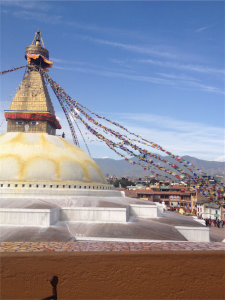 In 2011 I based myself in Nepal in order to further study and practice vajrayana Buddhism under my teacher’s guidance. After becoming Buddhist in my late teens, this was something I had wanted to do and prepared for for nine years. Growing up in southern California, I was not a stranger to earthquakes and I knew Nepal was a hot spot for large earthquakes as it sits where the Indian and Eurasian tectonic plates meet. Hence, over the last 40 million years the Himalayas were gradually formed. Whenever I walked through the narrow Kathmandu streets surrounded by poorly built buildings, it often popped in my mind that Nepal had not had a major earthquake in about 80 years. I always imagined somehow I wouldn’t be in Nepal when the big one hit, and with that thought I would simply carry on.
In 2011 I based myself in Nepal in order to further study and practice vajrayana Buddhism under my teacher’s guidance. After becoming Buddhist in my late teens, this was something I had wanted to do and prepared for for nine years. Growing up in southern California, I was not a stranger to earthquakes and I knew Nepal was a hot spot for large earthquakes as it sits where the Indian and Eurasian tectonic plates meet. Hence, over the last 40 million years the Himalayas were gradually formed. Whenever I walked through the narrow Kathmandu streets surrounded by poorly built buildings, it often popped in my mind that Nepal had not had a major earthquake in about 80 years. I always imagined somehow I wouldn’t be in Nepal when the big one hit, and with that thought I would simply carry on.
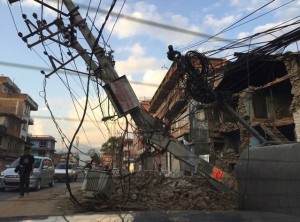 It was late morning on Saturday, April 25th when the initial 7.8 magnitude earthquake began. I was in my apartment near the great Boudhanath stupa with my girlfriend and sitting at my desk responding to a number of emails. Often, when we sit still and focus on something for a long time, we can feel our heartbeat subtly vibrate throughout our body. In the past I sometimes mistook this for a small earthquake, and when the very first shaking began I thought to myself, “You are just mistaking your own heartbeat for an earthquake again.” A few moments later my room began to shake violently and I knew this was a dangerous situation.
It was late morning on Saturday, April 25th when the initial 7.8 magnitude earthquake began. I was in my apartment near the great Boudhanath stupa with my girlfriend and sitting at my desk responding to a number of emails. Often, when we sit still and focus on something for a long time, we can feel our heartbeat subtly vibrate throughout our body. In the past I sometimes mistook this for a small earthquake, and when the very first shaking began I thought to myself, “You are just mistaking your own heartbeat for an earthquake again.” A few moments later my room began to shake violently and I knew this was a dangerous situation.
My girlfriend and I were fine, as were all of our friends. Though many of my native Nepali friends were not as fortunate, as they have family members who live in the hardest hit, remote and devastated regions of Nepal. I could see on their faces their experience of suddenly finding out their parents or siblings were now dead or missing. Some of these friends of mine are very good meditators, lamas and yogis who have dedicated their lives to dharma practice, and the way they were able to bear the sudden loss and take even the most gut-wrenching of human experiences onto their path was a great blessing to witness. Still now, many people are physically and mentally suffering due to the Nepal earthquakes and need help.
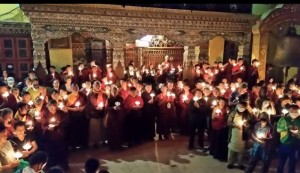 Though I was physically fine, it was a mentally challenging experience to see so much loss, devastation and uncertainty. Particularly in a place I have called home for a handful of years and in which I have been so spiritually cared for. My mom (Amy Izenberg) is part of a community of yoga and Reiki practitioners at the Param Yoga Healing Arts Center and she, together with many of them, were worried about me and kindly made me the focus of their healing practice. I am very grateful for their positive and loving intention towards me during this difficult time. The care we can give to others is based on our genuine intentions and our connection to each other. This is so beautifully expressed by one of my favorite Himalayan masters, the late Thinley Norbu Rinpoche:
Though I was physically fine, it was a mentally challenging experience to see so much loss, devastation and uncertainty. Particularly in a place I have called home for a handful of years and in which I have been so spiritually cared for. My mom (Amy Izenberg) is part of a community of yoga and Reiki practitioners at the Param Yoga Healing Arts Center and she, together with many of them, were worried about me and kindly made me the focus of their healing practice. I am very grateful for their positive and loving intention towards me during this difficult time. The care we can give to others is based on our genuine intentions and our connection to each other. This is so beautifully expressed by one of my favorite Himalayan masters, the late Thinley Norbu Rinpoche:
“If we believe in the continuity of mind, then love inconspicuously connects us to the ones we love with continuous positive energy, so that even tangible separations between people who love each other do not reduce the intangible power of love.”
Paul works with the Chokgyur Lingpa Foundation for earthquake relief in Nepal. To make a donation, click here.
Tuesday, Oct 14, 2014 A Passage to India
One of our yoga students, Josh, recently returned from a trip to India and wanted to share some highlights of his experience with the Param Yoga community. Here, in his own words, is Josh’s story:
In August 2014 I travelled with my son, Arjuna, to India for five weeks. The goal was to further our spiritual lives and to also, hopefully, have some extraordinary experiences. In the latter respect, the trip exceeded my expectations exponentially.
An Indian teacher of mine had advised spiritual aspirants travelling to India to “pack God in their suitcase”. In other words, God can be found anywhere. One does not have to travel to India. I, however, had a desire to see certain holy sites. Specifically, I wanted to visit Vrindaban (Krishna’s birthplace), Mayapur (a village where the Temple of the Vedic Planetarium, a $50 million edifice, is being built—I am very inspired by Vedic cosmology), and “the Hindu rat temple” (an obscure place I saw on the internet where hundreds if not thousands of rats run free in a sacred temple).
My son and I arrived in Calcutta at 3 AM. The airport is very antiquated. Even more antiquated are the cars outside the airport. Every car looked to have been from the early 1960s. Arjuna described the cars as resembling the flying car in Harry Potter. He was right—it might have been the same model.
The taxi took us to our hotel. The door was locked, but upon knocking, the hotelier, who was sleeping in the lobby awaiting our arrival, opened the door. The hotel attendant groggily came from a back room, clearly also having been awakened. He was wearing a tank t-shirt. The hotelier yelled at him to put on a proper shirt. We were ushered to our room where we went to sleep. I arose three hours later, so anxious to begin my Indian sojourn. We were on the outskirts of town, but I managed to find a taxi. Arjuna and I then went to Mother Teresa’s orphanage. I was surprised to see the “slums” of Calcutta. I hate to use the word, but really it is an apt description. Signs warning against malaria were omnipresent. Trucks with large tanks were delivering water.
At Mother Teresa’s, a group of Christian volunteers was there, departing to a satellite site to help the needy. Arjuna and I were the only ones left. A kindly nun asked if we would like a tour. We went inside and were inundated with dozens of lovely, happy Indian children. The walls were painted with merry colors. Staff and toys abounded. The children were readying themselves for school. Next we went to the second floor where the severely disabled children lived. Once again, the environment was very upbeat, with plenty of loving attention. Lastly, we visited the preschool children. They were singing songs like “Row, row, row your boat.” We joined in. Overall, a blissful experience!
That afternoon we went to the train station to travel to Mayapur. The station master said, “The train leaves in 3 minutes. It’s the local. Run and you’ll catch it.” We ran and hopped onto the “local” train, which I soon found out meant third class travel. The compartment was filled to the brim with street vendors transporting their wares back home after selling all day in Calcutta. Baskets 6 feet in diameter were stacked throughout the compartment, filled with everything from vegetables to lampshades. People were hanging out the door as we travelled. Our own luggage became part of the stack of goods in the middle of the car. We sat on the floor, no seats available. People were smoking, laughing, arguing. One person was smoking marijuana directly under the sign that said “No Smoking”. What fascinated me was the camaraderie. Every time we entered a new station I thought, “There is no way another vendor can squeeze in here.” But, with the help of the vendors already on the train, another big basket was lugged in and added to the precipitous stack. Amusingly, I thought, “How will a conductor come collect the tickets?” I found out later that the government does not collect fares from third class passengers, but just provides the service as a public good.
We arrived in Mayapur train station two hours later. A tuk-tuk (3-wheeled, open-air taxi) took us to a ferry, which took us to a bus and we arrived in Mayapur. There was a big, religious celebration going on, but luckily we were able to find accommodation at the guest house. Unfortunately for Arjuna, no television. We spent four days in Mayapur. One of the most exciting aspects was visiting the Temple of the Vedic Planetarium, which was under construction. We met the artisans who were crafting the large sculptures that would be housed within. Henry Ford’s grandson was the main benefactor. Ironically, he attended boarding school as a child with one of my best friends.
Our next destination was the Karni Mata Temple, which was clear across the width of India. The travel agent with whom I met said it would entail a 35-hour train ride. I said that was too long. He said the alternate was a taxi, a boat ride, a plane ride, and then another taxi. I said, “Okay we will take the train.” We departed from Calcutta. I was surprised to see hundreds (thousands?) of people lying on the immense train platform waiting for the departure of their train. I noticed a book stall hosted by the Ramakrishna Mission with an engaging photo of Swami Vivekananda. We were rushing to get to our train, so I did not purchase the book.
While waiting for the train departure, I began wondering what Arjuna and I would eat for 35 hours. Clearly these trains, built in the 1950s, had no “café car”. I happened to see a Pizza Hut, so I thought I will buy 4 large pizzas—at least Arjuna and I will not go hungry. I went to the “old station” next door to buy the pizza. In the meanwhile, a torrential downpour had begun. We were travelling during monsoon season. This must be one of those monsoons. Completely drenched, I returned to Arjuna and we boarded the train. The train was surprisingly comfortable. Now we were in “first class AC”—first class with air conditioning. We met the most interesting person—a Jain who spoke perfect English. He and his friends were on an overnight, religious pilgrimage. I never knew about the Jains, a sect of Hinduism. They do not eat anything that grows underground. Arjuna laughed as I asked, “So you’ve never had a French fry?”
The Pizza Hut pizzas were inedible. They had no flavor. Arjuna and I gave them to the conductor. Then, to our surprise, food came down the aisles. Vendors selling the most delicious tomato soup, vegetable chow mein, and veggie cutlet sandwiches, all for $.80 apiece. Even more remarkable, the time flowed quickly. The sleeping accommodations were marvelous. A Murphy bed, a curtain, and hand-delivered, fresh-pressed sheets, blanket and pillow were delivered by the conductor. I read Harry Potter and Arjuna studied his driving manual and listened to music.
We arrived at our destination in Bikaner and went to the Sri Ram Guest House. The hotelier greeted us, a kindly Indian fellow who luckily spoke perfect English. We came to learn that his father had started the guest house and was now retired. I met the father the following morning when I got up to do yoga on the cement landing outside my room. He marveled, “Westerners don’t usually awake early.” He and I spoke at length on spiritual matters. He was very wise and very friendly. That day his son took Arjuna and me to the Karni Mata Temple. Sure enough, hundreds (thousands?) of rats scurried over the altar of the temple and at our feet. Yet there were no rat droppings (someone must clean up). We were offered blessed food (halvah), which we ate. I then looked over and saw rats eating from the same portion.
In Bikaner we also had fun going on a sleepover in the desert with a camel and a guide. We also visited local artisans who spun thread and used a loom to make rugs and clothes.
Next we went to Vrindaban, birthplace of Krishna. Little did we know, but we arrived on the eve of Krishna’s birthday. On the actual day there were celebrations in every temple and in the streets. Flower garlands were offered to all, as well as delicious, blessed food in the form of an iced yogurt drink. Arjuna said, “I wish I could have five”—and, sure enough, five cups materialized! We became good friends with a kitchen worker named “Sim”. Sim invited us to his house for dinner. He lived in a hut in the countryside with five other men. He made us mashed potatoes and gave five rupees to a young local boy who ran to buy us a Mountain Dew. We rode back on a motorcycle, shouting religious exclamations: “Haribol!” “Hare Krishna!” This was Arjuna’s first motorcycle ride. An aside: in another city, we saw someone riding a motorcycle with a goat on it. Amusingly, while sightseeing on another day, a monkey stole my glasses.
The last two weeks of our tour was with a tour company: Veg Voyages. It was fun not having to worry about where to eat or sleep. We stayed at royal palaces and were given tours of the villages by a maharaja (AKA king—India is divided up into states; each state has a royal family, now in the seventeenth generation). At the village, we visited temples and drank warm buffalo milk from a street vendor. One of the highlights of this leg of the trip was volunteering for a week at an animal rescue. In India, cows, dogs, monkeys, pigs and goats roam the streets. Some get hit by cars. We tended to the wounded animals in a large sanctuary 20 minutes outside of Udaipur. Arjuna befriended a 3-legged goat. I became particularly fond of a blind monkey.
The trip ended. We were happy to be home.
Friday, Feb 10, 2012 Spiritual History of Los Angeles
 When he first arrived on the West Coast in 1925, Paramahansa Yogananda called Los Angeles “the Benares of America.” L.A. reminded him of India’s holiest city because a certain spiritual energy permeated the hot, dry air. He may have sensed that the growing town was destined to become the prime relay station for the processing and distribution of Yogic teachings.
When he first arrived on the West Coast in 1925, Paramahansa Yogananda called Los Angeles “the Benares of America.” L.A. reminded him of India’s holiest city because a certain spiritual energy permeated the hot, dry air. He may have sensed that the growing town was destined to become the prime relay station for the processing and distribution of Yogic teachings.
Yogananda himself, of course, played a principal role in that history. After making a 12-acre site atop Mount Washington the international headquarters of his Self-Realization Fellowship, he became “the 20th century’s first superstar guru,” to quote the LA Times. Over the years, Yogananda’s visible footprint was placed on other choice properties in the region, notably the magnificent Lake Shrine on Sunset in Pacific Palisades and the cliff top retreat in Encinitas, where he wrote his iconic memoir, Autobiography of a Yogi.
More than two decades before Yogananda made L.A. his home, Swami Vivekananda ushered in the 20th century in this part of the world. During his three-month visit commencing in December of 1899, lecture halls were filled with crowds eager to hear the triumphant star of the 1893 World’s Parliament of Religions speak on subjects like “The Science of Yoga.” In 1923, one of his devotees, Swami Paramananda, founded Ananda Ashrama, a still-functioning sanctuary in the hills of La Crescenta. A few years later, the triple-domed temple of the Vedanta Society rose up in Hollywood. There, in the 40s and 50s, a trio of celebrated authors, Gerald Heard, Christopher Isherwood and Aldous Huxley, were schooled in Vedanta philosophy and Yogic practices by the erudite Swami Prabhavananda, who presided over the temple from 1929 until his death in 1976 at the age of 82. The essays, novels and nonfiction books (e.g., Huxley’s seminal The Perennial Philosophy) produced by those literary lions educated millions about India’s spiritual treasures. Prabhavananda and Isherwood teamed up on elegant translations of the Bhagavad Gita and the Yoga Sutras (titled How to Know God) that were the best-read versions of those classics for years. The Hollywood center remains a custodian of Vivekananda’s vision of adapting the ancient dharma to the modern West.
The other Hollywood—the star-making industry, as opposed to the geographical entity—has also played a major role in beaming Yoga and Indian philosophy to the masses. As early as the 1930s, celebrities such as Charlie Chaplin and Greta Garbo would motor up to Ojai in their roadsters to listen to the pathless pathfinder, Jiddu Krishnamurti. It was in Ojai that the iconoclastic Krishnamurti had the spiritual breakthrough that led him to reject the messiah-like role for which he’d been groomed by the Theosophists who brought him to the West as a teenager. For nearly six decades, his spring lecture series drew thousands of Angelenos to Ojai annually.
Hollywood star power also taught folks in the hinterlands about Hatha Yoga. Celebs like Mae West and Greta Garbo were linked to the practice early on, and in the 1950s gossip columnists reported that icons such as Gary Cooper, Marlon Brando, and Marilyn Monroe were into it. Marilyn was said to do asanas “to improve her legs,” proving that Yoga as physical fitness did not begin in the Madonna era. One of the teachers of celebrities and thousands of others was Indra Devi, the so-called First Lady of Yoga, whose landmark book, Forever Young, Forever Healthy, coupled with numerous public appearances, helped bring the teachings to the masses. Born in Eastern Europe, she was a student of the legendary Hatha revivalist Tirumalai Krishnamacharya. Only an exceptional woman could have broken through India’s male-only Yoga club back then, and Indra Devi remained exceptional until her death in 2002 at the age of 102.
Among the region’s other mid-century Hatha teachers was Bishnu Charan Ghosh, Yogananda’s younger brother. One of his students was Bikram Choudhury, who went on to build a worldwide empire with his trademark high-temperature Yoga. Another innovator in L.A. at the time was Richard Hittleman. A devotee of the non-dualist saint Ramana Maharshi, Hittleman penned enormously popular books and pioneered the use of video. His daily TV show, “Yoga for Health,” debuted in L.A. in 1961 and was syndicated nationally for years.
In 1953, Judith Tyberg, a direct disciple of Sri Aurobindo, one of the spiritual giants of modern India, founded the East-West Cultural Center near the intersection of Beverly and Vermont. The center moved several times before settling into its present location in Culver City in 1985. A native San Diegan who studied Sanskrit in Benares, Dr. Tyberg introduced Angelenos to Sri Aurobindo’s work and hosted visiting teachers who went on to have a huge impact on modern Yoga. Among them was Swami Vishnudevananda, who was sent to America in 1957 by his guru, Swami Sivananda of Rishikesh. Ganga White, one of many seekers who found their way to East-West in the sixties, trained with Vishnudevananda and later opened the Sivananda Center for Yoga on Sunset and Western during the apex of flower power. The Hare Krishna devotees added to the colorful atmosphere of the era, giving locals their first glimpse of traditional Hindu Bhakti and their first earful of Sanskrit chanting, a precursor to today’s kirtan scene. They would soon establish an L.A. temple (now in Culver City) and, in 1977, start their annual Festival of Chariots in Venice.
In the seventies, White disconnected from the Sivananda lineage and turned The Center for Yoga into a prototype of today’s independent studio. It offered an eclectic menu of classes and hosted a parade of luminaries, from Swami Satchidananda to Allen Ginsberg to the first teachers trained by the influential Hatha masters B.K.S. Iyengar and Pattabhi Jois (Iyengar himself lectured there in 1976, as did Pattabhi Jois in 1985). The center caught on quickly, forcing a move to a larger location on Larchmont Boulevard, which is now owned by YogaWorks. White went on to found the White Lotus Foundation in Santa Barbara, and Swami Vishnudevananda’s lineage was reestablished as the Sivananda Yoga Vedanta Center, which is now located in Marina Del Rey.
The watershed moment in the West’s embrace of India’s spiritual heritage came when the Beatles met Maharishi Mahesh Yogi, studied his Transcendental Meditation (TM) and, in early 1968, famously retreated to the banks of the Ganges River. Overnight, words like mantra, guru, and ashram entered the collective vocabulary, and it became acceptable, even fashionable, to start the day in silent meditation. The locus of that phenomenon was London, but the sparks were lit years earlier in L.A. when clean-cut citizens of Ozzie and Harriet’s America were drawn to the Maharishi. When college students looking for ways to expand their awareness without dangerous drugs turned to TM, the Students International Meditation Society (SIMS) was created at UCLA. By 1966, SIMS had branches at several major campuses, and after the Beatles’ media explosion its office on Gayley Avenue became the administrative engine of a massive movement. One of the UCLA meditators, Keith Wallace, wrote his doctoral dissertation on the physiology of TM, and his findings, published in 1970, would jumpstart a research juggernaut that moved meditation into the mainstream.
The chain reaction that led directly to the Beatles began with an L.A. record producer named Richard Bock. The head of World Pacific Records, Bock started promoting the music of Ravi Shankar soon after the great sitarist’s first visit to the West in 1956. He produced some of Shankar’s early albums and connected him to L.A. based jazz artists like flutist Paul Horn, who became one of the first American TM teachers and later recorded the seminal “Inside the Taj Mahal” album. Bock also introduced Shankar to John Coltrane, who infused his music with Indian sounds and themes, and to Alice Coltrane, who went on to become a Swami with an ashram of her own in the Malibu hills. It was also through Bock that David Crosby, then a member of the Byrds, first heard Shankar’s music. Crosby shared his discovery with George Harrison in 1965, at a Benedict Canyon party. The rest is musical and spiritual history. While studying sitar with Shankar in India, the quiet Beatle’s spiritual longing found direction, and his path led to the historic Beatles-in-India moment.
Once the floodgates were opened, L.A. continued to be the principal conduit for the East-to-West transmission. Yogi Bhajan, who first appeared at the East-West Cultural Center in 1969, started teaching his distinctive Kundalini Yoga on Melrose Ave, down the road from the Bodhi Tree, which in 1970 established itself as the prototype for spiritual bookstores everywhere. Also starting up in a Melrose storefront (circa 1972) was the American guru who was born Franklin Jones, became Bubba Free John and, after more name changes, passed away as Adi Da Samraj.
Virtually every teacher whose impact reverberated nationally made important inroads in Los Angeles. Swami Muktananda, for instance, introduced his Siddha Yoga to Angelenos during his three world tours, beginning in 1970. On his first visit, he was accompanied by Ram Dass, who was then in the early stages of his indispensible life as the spiritual teacher formerly known as Harvard psychologist Richard Alpert. Mutkananda spent six months in L.A. on his third tour, holding public events in a huge tent in Santa Monica, where the Loews Hotel now stands. His successor, Swami Chidvilasananda (Gurumayi), also came to Los Angeles a number of times in the eighties and nineties. And, as local Yogis know, B.K.S. Iyengar and Pattabhi Jois, the progenitors of the asana-based practice now virtually synonymous with the word Yoga, established a powerful L.A. presence. The transmission continued through the turn of the century, as new teachers—Sri Sri Ravi Shankar, Mata Amritanandamayi, Sri Karunamayi, Sadhguru Jaggi Vasudev, and others—have found some of their most welcoming audiences in L.A.
Somehow, a city known for glitz and glamour also acquired a strong ethos of inner development. In what other city could Bhakti Fest, Yoga Month or Yoga therapy have been incubated? Where else could professor Christopher Chapple create a Yoga Studies program at the Jesuit-run Loyola Marymount University? Los Angeles has probably produced more Yoga teachers per capita than anywhere else in the country, and must surely lead the nation in the number of asanas performed and mantras intoned per day. By all indications, the Benares of America will continue to beam Yoga in all its forms as skillfully as it beams movies and TV shows.
Philip Goldberg, the author of American Veda: From Emerson and the Beatles to Yoga and Meditation, How Indian Spirituality Changed the West, is leading a workshop at Loyola Marymount’s Yoga Studies program on October 15th (www.AmericanVeda.com).
Courtesy of LA Yoga Online.
Thursday, Dec 22, 2011 Holiday Potluck
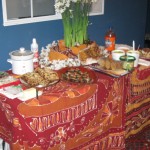 At our Holiday Potluck last night, we were struck anew by how truly blessed we are here at Param Yoga. Our wonderful students and friends arrived in droves bearing gifts of food that overflowed our tables. There was conversation and laughter as we celebrated the holidays together, including the lighting of the menorah and the singing of the Hebrew blessing by Stephanie Landau. As a special bonus this year, we were treated to a musical performance by the amazing Roxie Sakura and
At our Holiday Potluck last night, we were struck anew by how truly blessed we are here at Param Yoga. Our wonderful students and friends arrived in droves bearing gifts of food that overflowed our tables. There was conversation and laughter as we celebrated the holidays together, including the lighting of the menorah and the singing of the Hebrew blessing by Stephanie Landau. As a special bonus this year, we were treated to a musical performance by the amazing Roxie Sakura and 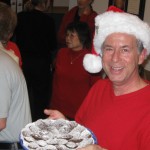 her talented band. Roxie is a gifted singer/songwriter and a valued member of the Param Yoga community. Her performance of the chant Om Namo Bhagavate, which she first heard in yoga class, drew a deep sigh and hearty applause from the audience. Marydale got up to speak afterwards and shared her 10 steps for anchoring your life in happiness.
her talented band. Roxie is a gifted singer/songwriter and a valued member of the Param Yoga community. Her performance of the chant Om Namo Bhagavate, which she first heard in yoga class, drew a deep sigh and hearty applause from the audience. Marydale got up to speak afterwards and shared her 10 steps for anchoring your life in happiness. 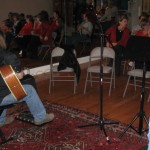 Many of you requested a copy of this list, which we will post on our blog soon.
Many of you requested a copy of this list, which we will post on our blog soon.
This year was an incredible first year at Param Yoga, and it is all due to our friends and students who have attended classes and workshops, participated in Reiki Share, and joined us for Yoga Day and other special events. You are the bricks that hold us together and the foundation of everything we do at the studio. We look forward to continuing our journey together in 2012 and beyond…
Thank you and Happy New Year!
Monday, Dec 12, 2011 Chatsworth Holiday Parade & Festival 2011
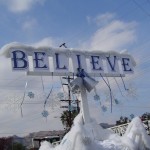 Thank you to everyone who contributed their time, talents, and enthusiasm to our float and booth in the Chatsworth Holiday Parade & Festival. The theme of the parade this year was The Polar Express. In the spirit of the movie’s message, we titled out float “BELIEVE”. The float consisted of a white pickup truck, lent and driven by Scott Thompson, pulling a flatbed trailer donated by Al and Cecilia Flaata. Our crew of volunteers
Thank you to everyone who contributed their time, talents, and enthusiasm to our float and booth in the Chatsworth Holiday Parade & Festival. The theme of the parade this year was The Polar Express. In the spirit of the movie’s message, we titled out float “BELIEVE”. The float consisted of a white pickup truck, lent and driven by Scott Thompson, pulling a flatbed trailer donated by Al and Cecilia Flaata. Our crew of volunteers 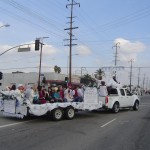 decorated the float in the Arctic colors of white, ice blue, royal blue, and silver, and covered it with pillowy cotton “snow” and glittering snowflakes. Marydale made incredible garlands of evergreen boughs with blue, white, and silver flowers, berries, and snowflakes, which framed the large Param Yoga signs attached to the front, side, and back of the float. Shimmering ribbons accented everything and trailed in the breeze. Griffin Thompson sat atop the truck representing the boy in The Polar Express, ringing his bell to let everyone know that he believes. Friends and
decorated the float in the Arctic colors of white, ice blue, royal blue, and silver, and covered it with pillowy cotton “snow” and glittering snowflakes. Marydale made incredible garlands of evergreen boughs with blue, white, and silver flowers, berries, and snowflakes, which framed the large Param Yoga signs attached to the front, side, and back of the float. Shimmering ribbons accented everything and trailed in the breeze. Griffin Thompson sat atop the truck representing the boy in The Polar Express, ringing his bell to let everyone know that he believes. Friends and 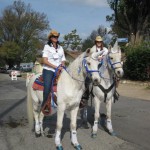 students of Param Yoga sat on hay bales in the trailer to ring their bells, wave to the crowd, and proudly represent the studio. Leading us in the parade were two magnificent horses on loan from Kelly Holland of Rancho Providencia. These beautiful animals were dressed to match our float and, in keeping with the magical theme of the parade, sported unicorn horns. Many people commented on the originality and beauty our float, and we are so appreciative of all those who made it possible. This holiday, remember to believe in yourself and to celebrate the magic of the season. Happy Holidays!
students of Param Yoga sat on hay bales in the trailer to ring their bells, wave to the crowd, and proudly represent the studio. Leading us in the parade were two magnificent horses on loan from Kelly Holland of Rancho Providencia. These beautiful animals were dressed to match our float and, in keeping with the magical theme of the parade, sported unicorn horns. Many people commented on the originality and beauty our float, and we are so appreciative of all those who made it possible. This holiday, remember to believe in yourself and to celebrate the magic of the season. Happy Holidays!
For more pictures of the Parade and Festival, visit our Facebook page.
Monday, Nov 14, 2011 11/11/11 Drumming Circle and Meditation
 Students and friends of Param Yoga met at the studio this past Friday night to celebrate the once-in-a-lifetime date of 11/11/11 with a drumming circle and meditation. This was our second drumming circle at the studio and was, if possible, more enthusiastic and energetic than the first. There is a special significance in numerology to the number 11, and this confluence of three 11s comes around only once in every century, so we are incredibly fortunate to have had the opportunity to experience it.
Students and friends of Param Yoga met at the studio this past Friday night to celebrate the once-in-a-lifetime date of 11/11/11 with a drumming circle and meditation. This was our second drumming circle at the studio and was, if possible, more enthusiastic and energetic than the first. There is a special significance in numerology to the number 11, and this confluence of three 11s comes around only once in every century, so we are incredibly fortunate to have had the opportunity to experience it.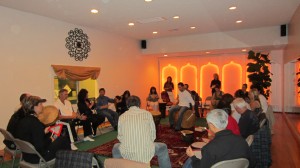
In astrology and numerology, 11 is considered to be a Master Number. It represents duality and should not be reduced to a single digit. It is believed that the number 11 possesses the qualities of balance, equality, and justice, along with the doubled attributes of the number 1, including higher ideals, invention, refinement, congruency, fulfillment, and vision. Whether there is any truth to this, many people feel a particular resonance to the number 11, especially when it occurs in multiples.
 Any reason is a good excuse to join together in community to celebrate our many blessings, so 11/11/11 was a natural call to gather in love and gratitude. Led by the amazing Ivor Weiner, we drummed, shook tambourines, and rattled maracas until the air thrummed with positive vibrations. We flowed this resonance into a guided meditation honoring the moment, all that had come before, and all that lay ahead. It was a beautiful evening and we thank everyone who participated and shared their loving energy with us.
Any reason is a good excuse to join together in community to celebrate our many blessings, so 11/11/11 was a natural call to gather in love and gratitude. Led by the amazing Ivor Weiner, we drummed, shook tambourines, and rattled maracas until the air thrummed with positive vibrations. We flowed this resonance into a guided meditation honoring the moment, all that had come before, and all that lay ahead. It was a beautiful evening and we thank everyone who participated and shared their loving energy with us.
Sunday, May 29, 2011 SRF Sunday Service – May 29, 2011
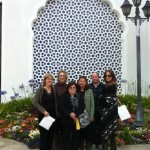 Alice, Marydale, Anet, Dina, Bob, and Sara attend Sunday services at the Self-Realization Fellowship Lake Shrine. We encourage members of our Param Yoga community to join us for events outside of the studio. If anyone is interested in attending Sunday services at the Self-Realization Fellowship, meet us at the back door of the studio every Sunday at 8:00 am. If nobody is here by 8:10 am, it means that we will not be going to services that week and you can continue on to the Lake Shrine by yourself or join us on another Sunday.
Alice, Marydale, Anet, Dina, Bob, and Sara attend Sunday services at the Self-Realization Fellowship Lake Shrine. We encourage members of our Param Yoga community to join us for events outside of the studio. If anyone is interested in attending Sunday services at the Self-Realization Fellowship, meet us at the back door of the studio every Sunday at 8:00 am. If nobody is here by 8:10 am, it means that we will not be going to services that week and you can continue on to the Lake Shrine by yourself or join us on another Sunday.

